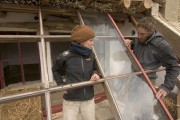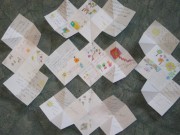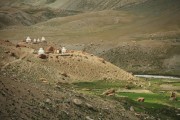Ladakhi Christmas
When the holidays started, we sunk into the celebration of the Buddhists New Year called Losar. For this event the holidays were set form the 16th till 27th of December. It was made also for us to celebrate our peaceful and Merry Christmas. The Losar celebration looks like this for us: we were invited by numbers of families at their homes to celebrate the Losar, which lasts for some days itself. But the number of days differs from village to village as we have seen. During this time the families use to visit each other, they are provided by food and chang and arak. It is a tradition to make some ibexes of tsampa for good luck. They also use to do spots on the beams of the ceiling by tsampa mixed with the butter. These spots are almost forever, till it is covered by the smoke. There are also many ceremonies bringing the happiness for the house. Small juniper brunches called shukpa are sacrificed as well as some other things. Otherwise people are mainly siting and chatting or later in the evening dancing. The women cook for all, some people fill the cups of all the guests more than we wish. The children are playing, older are doing some handworks such as knitting, making clothes, spinning the sheep wool or making ropes of the yak wool and so on. As the time is going on, people are getting drunk, the tapes with the ladakhi music are played and those who are to tired can sleep at the place just lying down and they will be covered by some blankets. The house can be also visited by children with masks. They dance, sing and then they get some gifts, mainly in form of money. The entertainment lasts late in the night and this is repeating for every day of the Losar. The stomach and the head is still under pressure and if you are not refusing the arak, even the liver suffer. We have spent three days like this, two of them in Kargyak and one in Schying. The reason to go to Schying was at first the invitation and second because we decided to visit the Phuktal monastery, the nearest one. This was the last chance for the visit because the wether could change anytime. So in the morning after celebrating the Losar in Schying we started our trek at nine o´clock walking on the ice of Kargyak Chu River and heading to Purne village. The weather was nice and the path was mainly very good. Just at Kuru village we lost the right path, but fortunately we met some of our acquaintances so he show us the right way. In the afternoon the water in the river roes up and overflowed the ice so we had to choose an other way meaning deep snow walking. Also the weather changed and the sky was covered by clouds when we reached the Purne village. We stood overnight at one of two families and tried to reach Phuktal next day. The ice on the Tsarap River was unfortunately overflowed by water with thin ice crust. We were wading through the water reaching our ankles and after some hundred meters we turned back to Purne where we stood for the rest of the day. This meant good luck for the family, because we have found dead ibex body during our short afternoon walk. Local people like ibex meat very much and they can enjoy it only in winter time, when the meat doesn´t spoil. They had a great joy and we pulled the body on the ice and some part of the way the father of the family carried the ibex on his back alone. They also did some ceremony around the body at the house. Next day we started again the walk to Purne. At first we used the chadar – frozen river, and then we climbed up on the summer track, which was easy to walk because of low snow cover. We followed the track till the monastery cut out in the rock face high above the river. There we spent two nights and went back to Kargyak. The monastery or better to say the life there was quite surprising to us. We expected quiet, silence and just praying and meditations. Because of numbers of small students in the monastery from the age of circa 8 years, the silence was rare. The kids are performing at least the same monkey business as our children do. The life looked similar to the life in the village in our experience. They gathered for the breakfast and the lunch on the sunny balcony where they can enjoy the sun even in deep winter. In the surrounding of the monastery there are few big junipers, holy for the villagers. They used the juniper as the firewood in the monastery. They don´t use the yak dung for heating at all. The monks – lamas used to visit the villages very often to provide some ceremonies. The villager also was visit the monastery to bring the firewood or some food. On the way back we joined lama Dawa, who was heading to Table, village close to Kargyak. He was going to do some ceremony for the house after the Losar finished. The way back was much faster because of good weather and good chadar. We reached Tangse that day and stood overnight at the family of one of our students from class 5. Next day we reached Kargyak despite the chadar was getting worse. It was the Christmas Day. Jirka cooked some special Christmas soup with the plums and mushrooms. The Christmas tree was made of dry bush and below there was also one gift for both of us. We sang carols and heated the stove with the yak dung. I thing we enjoyed a nice Christmas Day. On the Feast day we watched some fairytales and in the evening we visited our teachers. The celebration there was not in the Christmas spirit, but despite this the visit was nice. Celebrating in here means something different than in our country. The main slogan is “don, don” which means in case of the presence of chang or arak “lets drink, lets drink”.

 In now days are hppening big changes in Jammu and Kashmir.
https://www.bbc.com/news/world/asia/india
In now days are hppening big changes in Jammu and Kashmir.
https://www.bbc.com/news/world/asia/india  On September 21st, Kargyak Sun School will celebrate the 10th anniversary of its opening. There, in one of the last places on Earth, the original Tibetan culture survives at the elevation of 4200 m. Before the school opened, the village of 200 heads had only 10 members who could read and write a little. To get an education, children were sent away to boarding schools in faraway towns. Today, the Sun School has its alumni and thanks to the project, people stopped moving away from the village.
On September 21st, Kargyak Sun School will celebrate the 10th anniversary of its opening. There, in one of the last places on Earth, the original Tibetan culture survives at the elevation of 4200 m. Before the school opened, the village of 200 heads had only 10 members who could read and write a little. To get an education, children were sent away to boarding schools in faraway towns. Today, the Sun School has its alumni and thanks to the project, people stopped moving away from the village.  PRAHA 22.11.2018 | 19:00 Betlémská kaple
BRNO 21.11.2018 | 19:00 Milosrdní bratři
PRAHA 22.11.2018 | 19:00 Betlémská kaple
BRNO 21.11.2018 | 19:00 Milosrdní bratři 


